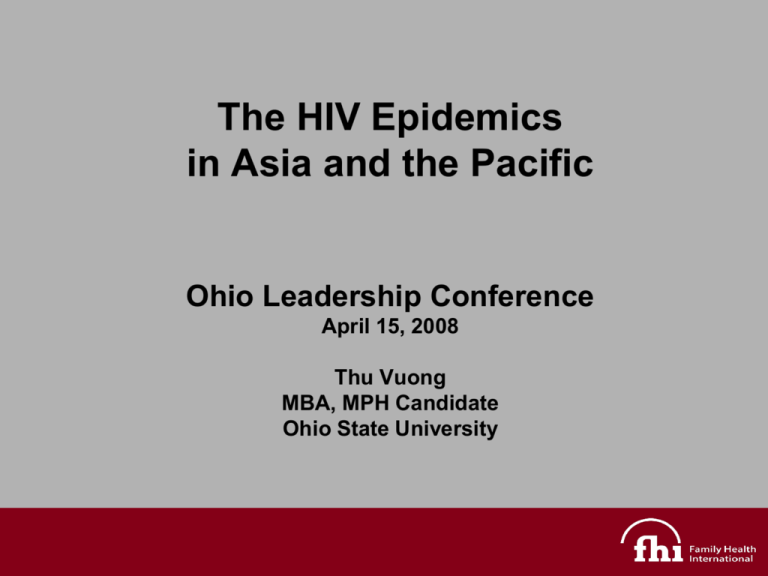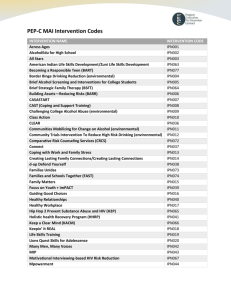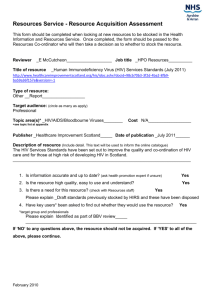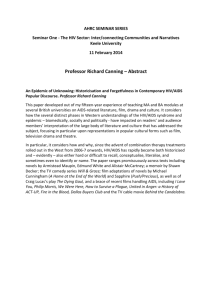
The HIV Epidemics
in Asia and the Pacific
Ohio Leadership Conference
April 15, 2008
Thu Vuong
MBA, MPH Candidate
Ohio State University
My Background
• Former Senior Program Officer, IDU Interventions,
FHI Vietnam
• Chair, Vietnam Harm Reduction Technical
Working Group, 2005-2006
• Trained Drug Addiction Treatment Counselor
• MBA, 2003
• MPH Candidate June 08, HSMP, OSU
Outline
• Epidemiology of HIV in Asia
• What works in HIV prevention: Why is Asia
different?
• US government support and policies regarding
HIV prevention, care, and treatment in developing
countries
• Country case study: Vietnam
• The future: Continuing challenges
Adults and children estimated to be living
with HIV as of end 2005
Western & Central Eastern Europe
& Central Asia
Europe
720 000
North America
1.2 million
[650 000 – 1.8 million]
Caribbean
1.6 million
[570 000 – 890 000] [990 000 – 2.3 million] East Asia
North Africa & Middle East
300 000
[200 000 – 510 000]
Latin America
1.8 million
[1.4– 2.4 million]
510 000
[230 000 – 1.4 million]
Sub-Saharan Africa
25.8 million
[23.8 – 27.9 million]
870,000
[440 000 – 1.4 million]
South & South-East Asia
7.4 million
[4.5 – 11.0 million]
Oceania
74 000
[45 000 – 120 000]
Total: 40.3 (36.7 – 45.3) million
Source: UNAIDS
Asian epidemics show great diversity and have
become more serious over time
4.8 million PLHAs in 2007 (UNAIDS)
1989
1994
< 0.05%
0.05 - 0.1%
0.10 - 0.5%
0.50 - 1.0%
> 1.0%
1999
2003
Stages of the HIV Epidemic by
UN/WHO classification
• Low Grade
– Prevalence of HIV is consistently below 5% in any
“high risk groups” and below 1% in the “general
population”
• Concentrated
– Prevalence of HIV has surpassed 5% on a
consistent basis in one or more “high risk groups”
but remains below 1% in the “general population”
• Generalized
– Prevalence of HIV has surpassed 1% in the
“general population”
Source: UNAIDS
HIV Epidemic Summary in AsiaPacific Region
• Three countries in Asia have generalized epidemics:
– Cambodia (1.6%), Thailand (1.4%), and Myanmar
(1.3%)
• Rapidly expanding concentrated epidemics include
India, Indonesia, Nepal, Vietnam and several provinces in
China
• One country in the Pacific now is also on the verge of a
generalized epidemic – Papua New Guinea
– Possibility for an ‘African-style’ epidemic
HIV Epidemic Summary in AsiaPacific Region (cont’d)
• But even within
one country,
there is
significant
variation in
epidemic
spread
– India, China
Adult HIV prevalence among African countries in 2005
40
35
30
25
20
15
10
5
Sw
az
ila
Bo n d
ts
w
an
a
Le
so
th
o
Zi
m
ba
bw
e
N
am
So
ib
ia
ut
h
Af
ric
a
Za
m
M
bi
oz
a
am
bi
qu
e
M
al
aw
i
Ta
nz
an
ia
Ke
ny
a
N
ig
er
ia
R
w
an
da
0
Source: UNAIDS/WHO 2006 Report on the global AIDS epidemic
Adult HIV prevalence among Asian countries in 2005
1.8
1.6
1.4
1.2
1
0.8
0.6
0.4
0.2
Source: UNAIDS/WHO 2006 Report on the global AIDS epidemic
Ba
ng
la
de
sh
*
Si
ng
ap
or
e*
pi
ne
s*
ia
*
Note: * <0.1
Ph
ilip
al
ay
s
M
C
hi
na
N
ep
al
Vi
et
na
m
In
di
a
a
Bu
rm
Th
ai
la
nd
C
am
bo
di
a
0
What's the big deal with HIV in Asia?
• With a few exceptions, Asia epidemics will not
reach the high levels seen in the highest
prevalence in sub-Saharan African countries
• So what’s the big deal?
• Even a low-grade epidemic in Asia means
millions of people (60% of world population – 4
billion)
Every percentage point in Asia adds a
huge number to the global epidemic
Country
Adult population
1% adds this to global
pandemic
China
726 million
7.3 million
India
533 million
5.3 million
Indonesia
118 million
1.2 million
Bangladesh
72 million
720,000
Pakistan
67 million
670,000
Vietnam
43 million
430,000
Total=15.5 million
1% increase in adult HIV prevalence in SS Africa=2.9 million
What drives the spread of HIV in
Asia?
Factors that drive the spread of HIV
• Major behavioral factors
– Unsafe blood transfusion
– Needle sharing
– Multiple heterosexual partners engaging in unprotected
sexual intercourse
– Multiple homosexual partners engaging in unprotected
anal sex
– Commercial sex
• Major co-factors
– Presence of other STI
– Non-circumcision
Socio-economic factors that may affect HIV
epidemic spread
• Poverty
– Higher levels of commercial sex
– Higher levels of drug use
– Less access to quality health care
• Travel/Migration
– Long-distance truck drivers, seafarers…
– Men living without their families; Higher use of sex
workers
– Female migrants
Social and cultural factors in Asia
promoting or inhibiting HIV spread?
• A tolerance for men, strict prohibition for women
• Loosening sexual norms in Asia
• Increasing age at marriage producing large pool of
unmarried youth
• Gender inequality
– Reduces employment opportunities, promoting sex
work
– Limits negotiating ability in relationships
“It’s very difficult to speak about ‘the Asian
epidemic’. Whatever we come up with, we
always find a big exception in Asia.”
(Dr. Peter Piot, UNAIDS Executive Director)
So what explains the variations between
countries?
• Levels of risk
– Frequency of needle sharing, sexual activity
– Sizes of at-risk populations, especially drug users,
sex workers and clients of sex workers
• Linkages among at-risk sub-populations
• Behavior change in response to prevention
• Timing of HIV introduction into the high-risk groups
• Biological factors such as STI and circumcision
HIV prevalence among IDUs far
outstrips sex worker prevalence in
most places
(Source: National surveillance reports)
If HIV infection is highest among IDUs,
why is it claimed that commercial sex is
the main driver of HIV epidemics in
Asia?
• Absolute numbers
• IDU more likely to be infected
• More HIV infections overall will be
transmitted sexually
Dynamics of Asian HIV/AIDS epidemics
MSM
IDUs
FSW
Clients
Low or no risk
males
Early infections focused in at-risk groups:
Clients & FSW, IDU and MSM.
These groups strongly linked behaviorally
Low or no risk
females
Newborns
IDUs visit sex workers
Percent of injectors visiting sex workers last year
Percent visiting sex workers
80
60
40
20
0
r
Su
ay
b
a
a
20
02
B
de
sh
SE
B
20
s
de
02
h
C
a
tr
n
e
0
l2
02
B
an
o
gk
k
19
89
Ja
rta
a
k
20
02
H
o
an
0
i2
00
B
an
ng
u
d
02
20
B
s
de
h
N
W
20
02
H
p
ai
ng
o
h
0
20
0
H
C
CM
Sources: National surveillance systems. *Bangladesh values are for the last month.
20
00
C
an
o
th
20
00
Impediments to HIV Prevention in Low
Prevalence/Emerging Epidemic Countries
Low Prevalence
= Low priority
= We’re different - “Risk behavior does not
happen here so there’s no need to respond”
= Lack of capacity
= Tendency to focus on politically popular but
epidemiologically inefficient groups, e.g.
general population
= Vicious circle of lack of data → no response
→ lack of data….
Low prevalence among whom?
• Asian countries have overall low HIV
prevalence
Higher prevalence in higher risk populations
Need to focus on these higher risk
populations
SOUTH & SOUTH-EAST ASIA
Estimated number of injecting drug users (IDUs)
HIV prevalence among IDUs (mid est.1998/2005)
IRAN: 206,000
AFGHANISTAN:
0.5%
34,080
unknown
BHUTAN:
unknown
NEPAL: 41,000
Up to 60%
PAKISTAN:
462,000
unknown
LAOS: 8,000
unknown
INDIA: 1,294,000
MYANMAR:
195,000
Up to 79.5%
68.4%
BANGLADESH:
98,000
2.6%
THAILAND:
57,000
54%
MALDIVES
unknown
SRI LANKA: 28,241
unknown
VIET NAM: 128,000
64%
PHILIPPINES:17,000
1%
MALAYSIA: 19,500
35.5%
SINGAPORE: 15,000
1.7%
INDONESIA: 580,000
47%
Factors that increase HIV transmission
associated with IDU
• Sharing and re-using injecting equipment (due to lack of
clean needles & syringes or fear of arrest and beatings
by the police)
• Professional injectors and shooting galleries
• Sexual behaviour of IDUs
– Selling sex to buy drugs
• Women IDUs selling sex to buy drugs
• Male IDUs selling male-male sex to buy drugs
– Drug injectors buying sex
• Imprisonment or drug treatment centers
(Source: SHARAN Archives. 2000)
IDU “Mixing” in Prisons
A
B
C
D
IDU
Network
HIV -ve
IDU
Network
HIV +ve
IDU
Network
HIV -ve
IDU
Network
HIV -ve
PRISON
A
B
D
C
A
B
C
D
IDU
Network
HIV +ve
IDU
Network
HIV +ve
IDU
Network
HIV +ve
IDU
Network
HIV +ve
Epidemics among FSW often follow
IDU epidemics
70
60
50
40
30
20
10
0
1994
1995
1996
Guangxi, IDU
Hanoi, sex workers
1997
1998
1999
2000
Guangxi, sex workers
Jakarta, IDU
2001
2002
2003
Hanoi, IDU
Jakarta Sex workers
Essential HIV prevention package:
weighting varies by country
• Confront stigma and discrimination
– National leadership, mass media, education
• Prevent sexual transmission
– Condoms and social marketing for FSW, clients, MSM
– Reducing number of sexual partners
– Delaying sexual debut
• Prevention of IDU transmission
– Harm reduction programs including substitution therapy
– Peer counseling
• Voluntary counseling and testing
– Confidentiality and consent
Essential HIV prevention package:
weighting varies by country
• Prevention of MTCT
– Antenatal screening
• Focus on HIV prevention among youth
– Peer counseling, mass media campaigns, school education
•
•
•
•
Integrate prevention into treatment services
Treatment of STIs
Workplace programs
Ensuring safety of blood supply
– Transfusion screening
• Preventing HIV transmission in healthcare
settings
– Universal precautions
Example of a full HIV prevention,
care, and treatment program:
Vietnam
HIV/AIDS in Viet Nam
• Initially largely driven by injection drug use and,
to a lesser extent, by sex work
• Moved into general population with husband-towife-to-child transmission, through the sexual
networks of drug users and clients of sex
workers
• Women now account for one-third of all new
infections
How the US government supports HIV
programs in developing countries
• Two major US government agencies:
USAID, CDC
• These agencies can provide funding
directly to ministries of health
• They can also provide them through
technical organizations and universities
– FHI and UNC are two that are very active in
HIV and other diseases internationally
US government policies regarding HIV
prevention: myths and realities
• The PEPFAR initiative has brought tremendous
resources to HIV treatment in addition to
prevention and care
– 15 focus countries; $15 billion for 5 years
– President Bush has just requested a doubling of
this amount
• Contrary to the belief of many, PEPFAR fully
supports condom promotion to FSW, their clients,
and MSM
US government policies regarding HIV
prevention: myths and realities (cont'd)
• 20% of prevention funding must go to abstinence
programming (some countries receive a waiver,
e.g. Vietnam)
• No funding can be used to support the purchase or
distribution of syringes or needles for IDUs
• Partners must sign a pledge that they do not
support the legalization of prostitution nor will funds
be used for this.
– In 2005, DKT International is challenging this in
court because they refused to certify its
opposition to prostitution
FHI HIV Program focus in Vietnam
• Prevention interventions to address behaviors at the core
of the epidemic – drug use, commercial sex work and sex
among men (i.e., IDUs, FSWs and their clients, and
MSM)
• Care and treatment interventions at district level to
provide treatment, care and support for people living with
HIV/AIDS (PLWHA)
• Integrated bio-behavioral surveillance to understand the
direction of the epidemic, behavior change, and
estimates of HIV infection
Interventions for IDU: strategic approaches
• Peer outreach to
shooting locations and
drop-in center services
• Drug addiction
treatment counseling
with relapse prevention
• Substitution treatment:
Methadone substitution
treatment planned for 3
sites for 2008
Strategic approaches to reaching
clients of FSW
• Reaching at-risk men at
entertainment
establishment (beer
houses, bars, restaurants,
coffee houses) with “Live
Like a Real Man" messages
• A dedicated hotline with
experienced counselors
• Strong linkages with the
mass media component
Strategic approaches for FSW
• Peer outreach to FSW based
on mapping of commercial sex
• Condom distribution
• Drop-in centers with integrated
services (VCT, STI,
counseling, edu-tainment,
referrals)
Interventions for MSM: strategic approaches
• Peer outreach to
discos, bars, and
locations where men
meet for sex
• Drop-in center for edutainment and peer
discussions
• Internet intervention
Drug "rehabilitation centers":
a unique challenge in Vietnam
• Government of Vietnam (GoV) began addressing drug
“problem” 10 years ago with a “social evils” perception.
• Main strategy was placement in drug rehabilitation
centers (known as 06 Centers – “labor and education”)
– Mandatory detoxification
– Rehabilitation through lectures on drug use, risk of HIV
transmission
– Vocational training
Drug "rehabilitation centers": a unique
challenge in Vietnam
• By 2006, 83 rehabilitation centers were in operation,
with up to 57,000 residents
• GoV noticed high rates of relapse (>90%) from 2 year
rehabilitation period and so increased the length of time
to up to 5 years
• Spiraling costs of 06 centers and high HIV rates (up to
50% HIV+) forced willingness to view alternative
approaches
• With PEPFAR support, FHI and others are
"rehabilitating" the rehabilitation centers
Continuum of services for individuals transitioning
from 06 centers back to their communities
06 center services
Community-based
services
Proposed interventions:
Proposed interventions:
•
•
•
•
•
• Continued case management
by case managers and social
workers in community
• Linkages to:
• Health facilities, VCT, ARV
• Support groups
• Home care teams
• Relapse prevention including:
• Narcotics Anonymous
• Job placement
• Methadone
• Family and peer support
groups
case management
VCT
Assessment
HIV prevention
Drug relapse and
addictions counseling
• Psycho-social needs
care
• ARV and OI treatment
Breaking the cycle:
Ensuring services to prevent
drug use relapse and reduce
placement back in centers
• Pre-departure planning and “handover” from 06 center
case managers to community-based case managers
Knowing what we (Asia) do, why are
HIV programs still failing?
•
•
•
•
Focus and misdirection
Capacity for quality programming
Coverage
Political will
Why do we fail?: Focus and misdirection
• Global and national program misdirection
– African paradigms in Asian settings – ABC
– USG restrictions on harm reduction (needles
and syringes)
– Social order and social evil campaigns
Why do we fail?: Capacity
• National program capacity
– Understaffed, overburdened, lacking some
skills sets
• NGO and community capacity
– Great development capacity
– Little experience with HIV & marginalized
groups
• International support capacity
– Limited technical staffing and consultant base,
largely from outside
Why fail?: lack of size estimation/
coverage data
• Most countries do not yet have size estimates
of critical groups:
– Sex workers, clients, IDU, MSM
• Difficult to know:
– what each group’s role is in the epidemic
– what coverage goals should be to make a
difference
Why do we fail? Political will
• Countries successful against HIV have
– Leadership from the top
– Grass roots efforts working upward
– Societal mobilization
• But many Asian leaders (& their replacements):
– do not acknowledge risk – HIV/AIDS is not really an
Asian problem
– do not understand their epidemics – infection will
restrict itself to high-risk groups
– do not support work with marginalized groups
Asia – Boom or Bust?
• The next sub-Saharan Africa? No
• 3-5% possible in some countries? Yes
• Can we stop it? Yes, by
– Focusing in the right places, with the right prevention
services, and for the right people
– Mobilizing the resources to go to scale; The time for
“boutique” pilot projects is long past
– Building country capacity to respond in the most
effective manner
Thank You Slide
Robert Ali, University of Adelaide, Australia
Stephen Mills, FHI Vietnam
Tobi Saidel, FHI India
Dimitri Prybylski, FHI Bangkok
Tran Vu Hoang, FHI Vietnam
Tim Brown, University of Hawaii, Hawaii, USA
Fritz Van Grievsen, US-CDC, Bangkok
Philippe Girault, FHI Bangkok




